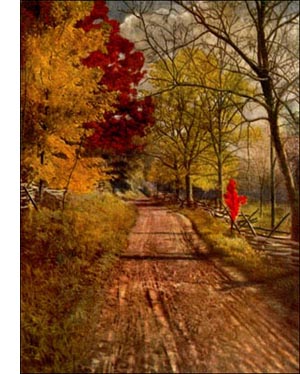Cockspur Thorn Tree
 Cockspur Thorn (Crataegus Crus-galli, Linn.)-A small, handsome tree, 15 to 25 feet high, with stiff branches in a broad, round head. Thorns axillary, stout, often curved, brown or grey, 3 to 4 inches long, often becoming 6 to 8 inches long and branched when old. Bark grey or brown, scaly, branchlets smooth, green, becoming brown, then grey.
Cockspur Thorn (Crataegus Crus-galli, Linn.)-A small, handsome tree, 15 to 25 feet high, with stiff branches in a broad, round head. Thorns axillary, stout, often curved, brown or grey, 3 to 4 inches long, often becoming 6 to 8 inches long and branched when old. Bark grey or brown, scaly, branchlets smooth, green, becoming brown, then grey. Wood brownish red, close grained, hard, heavy, takes satiny polish. Buds small, scaly, brownish red. Leaves thick, leathery, lustrous, dark green above, paler beneath, 1 to 4 inches long, obovate; acute or rounded and serrate at apex; entire below middle and tapering to the stout petiole; veins netted; stipules paired, strap shaped, or obliquely ovate, falling early. Autumn colours orange and scarlet.
Flowers, May to June, after leaves, in racemose corymbs, loose, many-flowered, with smooth stems, blossoms spreading, white, 2/3 inch across; sepals and petals 5; stamens to, with rosecoloured anthers; styles usually 2.
Fruit, October, remain till spring, almost globular, 1/2 inch long, dull red, with dry, thin, mealy flesh; calyx lobes dry and spreading at apex; nutlets 2, deeply grooved on back. Preferred habitat, rich soil of low hill slopes.
Distribution, Montreal region to southern Michigan; south to Delaware and Pennsylvania; along Appalachian foothills into North Carolina. Uses: Cultivated as an ornamental and in hedges in Europe and America. Wood used for tool handles, levers, etc.
Wherever a cockspur thorn is planted, in open lawn with elbow room, or in a crowded shrubbery border, it keens its character, and gives the passerby a distinct impression of something new and different. It is like an interjection met in the even swing of a long sentence.
There are vigour and strength expressed at any age by the tree's rigid, zigzag branches, armed with long, sharp spurs. The thorns strike downward, as a rule; on horizontal branches. The leaves stand up "on tiptoe," as if to keep out of the way. Indeed, they might be taken for weapons themselves, they are so thin, and keen edged, and shining. From the ground up, on young trees, the bark is bright and polished, varying from red to brown and grey.
The flowers are late, coming out in showy clusters when the full-grown leaves make a lustrous background. The fruits make little show until ripe, for the leaves are rarely touched by fungous or insect injuries, and in the fall, when the fruit begins to flush, the foliage takes on the colours of flame. 'The dull red clusters glow with a subdued warmth on the branches all winter. The birds let them alone.
So all year long the cockspur is a beautiful ornamental tree, and a competent and popular hedge plant. It is the favourite American thorn in Europe and at home, known for two centuries, and named by Linnaeus, one of the proud old "first families" of the genus Crataegus.
Crataegus Mohri, Beadl., is a slender thorn tree, close of kin to the other cockspurs, as we recognise by its shining leaves, slender spines and thin-fleshed fruits, with nutlets deeply grooved on the back. It belongs to the group of cockspur thorns whose flowers and fruits are borne on pubescent pedicels. There are twenty stamens, with yellow anthers, set in three rows.
This straight thorn tree has spreading and rather pendulous limbs, and short, shiny, brown spines. Its range centres in Alabama, whence it extends into Georgia, Mississippi and Tennessee. Its favourite situations are moist, level woodlands.
It promises to be for the South what C. Crus-galli is in the Northeastern States- a handsome, useful ornamental and hedge tree.